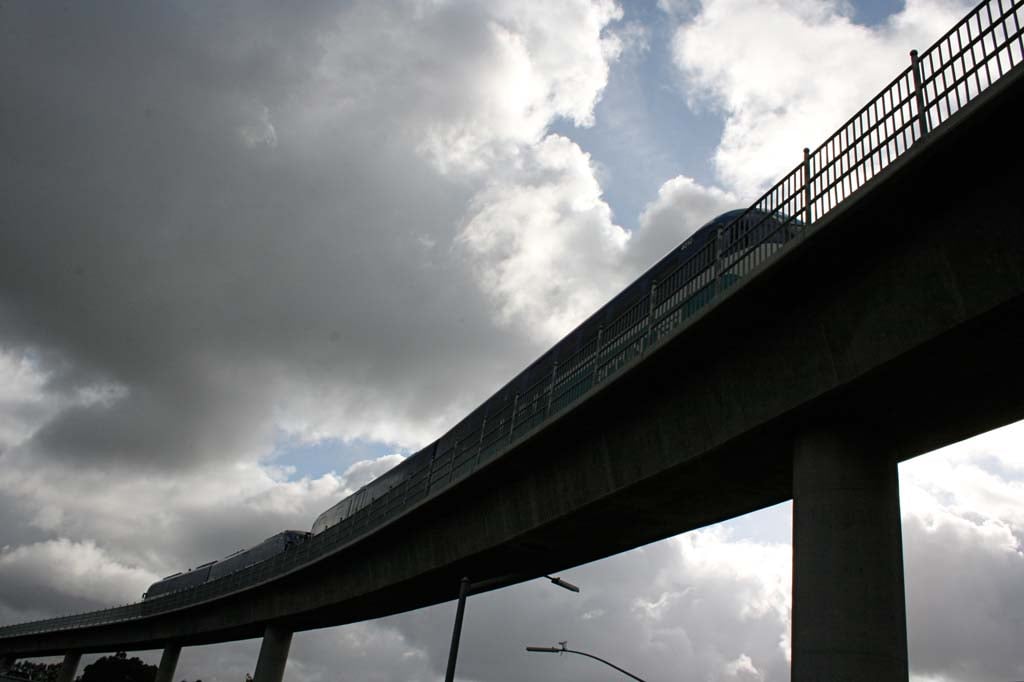SAN MARCOS — The sight of the flashing lights of emergency vehicles and firefighters scaling a five-story ladder to reach the Sprinter light rail on March 27 was only a practice drill. In the event a true emergency occurs, firefighters and NCTD (North County Transit District) will have this practice under their belts.
NCTD and the SMFD (San Marcos Fire Department) have plans and procedures in place to respond to a variety of emergencies. Both agencies say more can be learned from each response.
“We are good at our daily jobs and smaller issues,” Laynie Weaver, NCTD transit safety and emergency preparedness manager, said. “It’s (with) the bigger ones we don’t see as much practice.”
Drills are held regularly to fine tune responses.
The fire department holds four emergency drills a year. Each drill focuses on a different scenario and allows firefighters to use equipment in a different way.
Rescue drills vary and include freeing people from a water reservoir, a confined space and a trench.
“Do we get called to do rescues like this every day? No,” Chuck Morton, SMFD division chief, said. “Do we want to perform like we get them every day? Yes.”
Firefighters are not alerted about the drill until the call comes in. They proceed just as they would to a true emergency.
“The whole goal of what we do each quarter is to surprise them and learn what we need to focus on,” Morton said. “The management team knows the written plan, but we keep it quiet right up to the drill.”
NCTD transit enforcement takes on emergency drills a bit differently. One to two drills are held each year.
Extensive coordination has to be put in place to ensure there is no rail traffic at the location the drill is performed.
During the drill, NCTD security and safety personnel are on the scene to coordinate efforts between first responders, police, track maintenance personnel and rail engineers.
In a true emergency the NCTD control center puts out emergency calls to all responders involved.
The first order of business is to stop any other rail traffic.
“Trains are not able to go right or left, and it takes them some time to stop,” Jaime Becerra, NCTD chief of transit enforcement, said.
Rail emergencies can vary from debris on the track to a collision.
There are also differences between the Sprinter, Coaster and freight trains, in their weight, speed and what they carry on board.
“They are built different,” Weaver said. “They run by different rules. They have different access and egress points.”
The Sprinter is the lightest train and travels at the slowest speed, which reaches a maximum of 55 miles per hour.
A Sprinter train traveling 50 miles per hour, on a level grade, with a full load of passengers, would take about 13 seconds to reach a full stop once the emergency break is applied. In 13 seconds the train would travel another 450 feet.
The emergency drill on March 27, involved evacuating passengers from a Sprinter stopped on the overpass spanning Woodland Parkway. The scenario included evacuation of a handicapped passenger.
“What’s unique about this type of evacuation is a wheelchair lift is included,” Becerra said. “Firefighters are notified it is a drill exercise, and respond in real time to address the scenario. There’s definitely a lot of lessons learned on both sides.”
Fire dispatch for this type of emergency includes a fire engine, a paramedic company and a ladder truck.
After the drill there is an on-site review by all agencies involved. Each agency takes information learned back to their staff.
“It keeps everyone up on their training and skills,” Morton said. “If one thing doesn’t work, it’s something we can focus on. All shifts can learn from this drill.”
Weaver said it’s also important for train riders to be prepared and plan an alternate way to get to work and back home if an emergency causes rail traffic to stop.
“There’s less anxiety if you have thought about other options,” Weaver said. “We never plan for these things to happen, but it’s life.”



